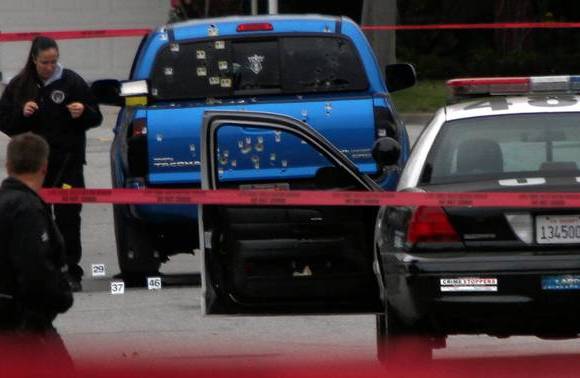February 10, 2013
The women were victims of 'a tragic misinterpretation' by officers working under 'incredible tension,' LAPD Chief Charlie Beck says.
It was around 5 a.m. in Torrance on Thursday and police from nearby El Segundo had seen a pickup truck exit a freeway and head in the general direction of the Redbeam Avenue residence of a high-ranking Los Angeles police official, which was being guarded by a group of LAPD officers.
Police were on the lookout for Christopher Jordan Dorner, a disgruntled ex-cop suspected of hunting down members of the LAPD and their families in a twisted campaign of revenge. The radio call indicated that the truck matched the description of Dorner's gray Nissan Titan.
A few minutes later, a truck slowly rolled down the quiet residential street.
As the vehicle approached the house, officers opened fire, unloading a barrage of bullets into the back of the truck. When the shooting stopped, they quickly realized their mistake. The truck was not a Nissan Titan, but a Toyota Tacoma. The color wasn't gray, but aqua blue. And it wasn't Dorner inside the truck, but a woman and her mother delivering copies of the Los Angeles Times.
In an interview with The Times on Friday, LAPD Chief Charlie Beck outlined the most detailed account yet of how the shooting unfolded. Margie Carranza, 47, and her mother, Emma Hernandez, 71, were the victims of "a tragic misinterpretation" by officers working under "incredible tension," he said. Just hours before, Dorner allegedly shot three police officers, one fatally. And, in an online posting authorities attributed to him, Dorner threatened to kill more police and seemed to take responsibility for the slaying over the weekend of the daughter of a retired LAPD captain and her fiance.
Beck and others stressed that the investigation into the shooting is in its infancy. They declined to say how many officers were involved, what kind of weapons they used, how many bullets were fired and, perhaps most important, what kind of verbal warnings — if any — were given to the women before the shooting began.
Law enforcement sources told The Times that at least seven officers opened fire. On Friday, the street was pockmarked with bullet holes in cars, trees, garage doors and roofs. Residents said they wanted to know what happened.
"How do you mistake two Hispanic women, one who is 71, for a large black male?" said Richard Goo, 62, who counted five bullet holes in the entryway to his house.
Glen T. Jonas, the attorney representing the women, said the police officers gave "no commands, no instructions and no opportunity to surrender" before opening fire. He described a terrifying encounter in which the pair were in the early part of their delivery route through several South Bay communities. Hernandez was in the back seat handing papers to her daughter, who was driving. Carranza would briefly slow the truck to throw papers on driveways and front walks.
As bullets tore through the cabin, the two women "covered their faces and huddled down," Jonas said. "They felt like it was going on forever."
Hernandez was shot twice in her back and is expected to recover. Her daughter escaped with only minor wounds from broken glass.
Though Beck said he does not doubt the women did not hear any verbal commands, he emphasized that it was still possible the officers did attempt to stop the vehicle before opening fire. And, while not commenting specifically on this shooting, Beck said it was not difficult to imagine how officers who were already on edge could make the mistake these officers did.
"As an officer, you look for cues. You know how someone drives normally and then you see someone coming at you slowly, driving in the middle of the street, stopping and starting. That can be misinterpreted," he said.
Beck said he had not yet received a detailed briefing, which typically occurs a few days after officer-involved shootings to give investigators time to collect evidence and put together the basic summary of what happened. But he did say that the gunfire occurred in two bursts: The first came from an officer positioned down the block from the LAPD official's residence, and the second when Carranza accelerated away from the gunfire and toward other officers.
After the investigation is completed, Beck and an oversight board will decide if officers were justified in the shooting or made mistakes that warrant either punishment or training.
Jonas estimated that the officers fired between 20 and 30 rounds. Photographs of the back of the truck showed at least two dozen bullet holes. Neighbors, however, suggested there were more shots fired.
A day after the shooting, residents in the street surveyed the damage.
Kathy Merkosky, 53, was outside her stucco home pointing out the six bullet holes in the bumper and grill of her silver Acura MD-X. She knew her truck was damaged when she spotted it on television and "saw fluid flowing into the street."
Her Ford Focus was hit as well — a bullet shattered the windshield and another flattened a front tire.
"I've never heard gunfire on my street," Merkosky said. "Or ever in my life.... I hope they catch the guy so all this craziness will end."
Goo also was startled by the early-morning blasts.
"When I heard all the pop-pop-popping, I dropped to the ground, crawled around and pulled my wife out of the bed and I got on top of her," he said.
Goo said he could hear the bullets hitting the front door and feared they were coming through the house. He said he called 911 for the police, but was notified that they were already there.
source: L A Times

No comments:
Post a Comment